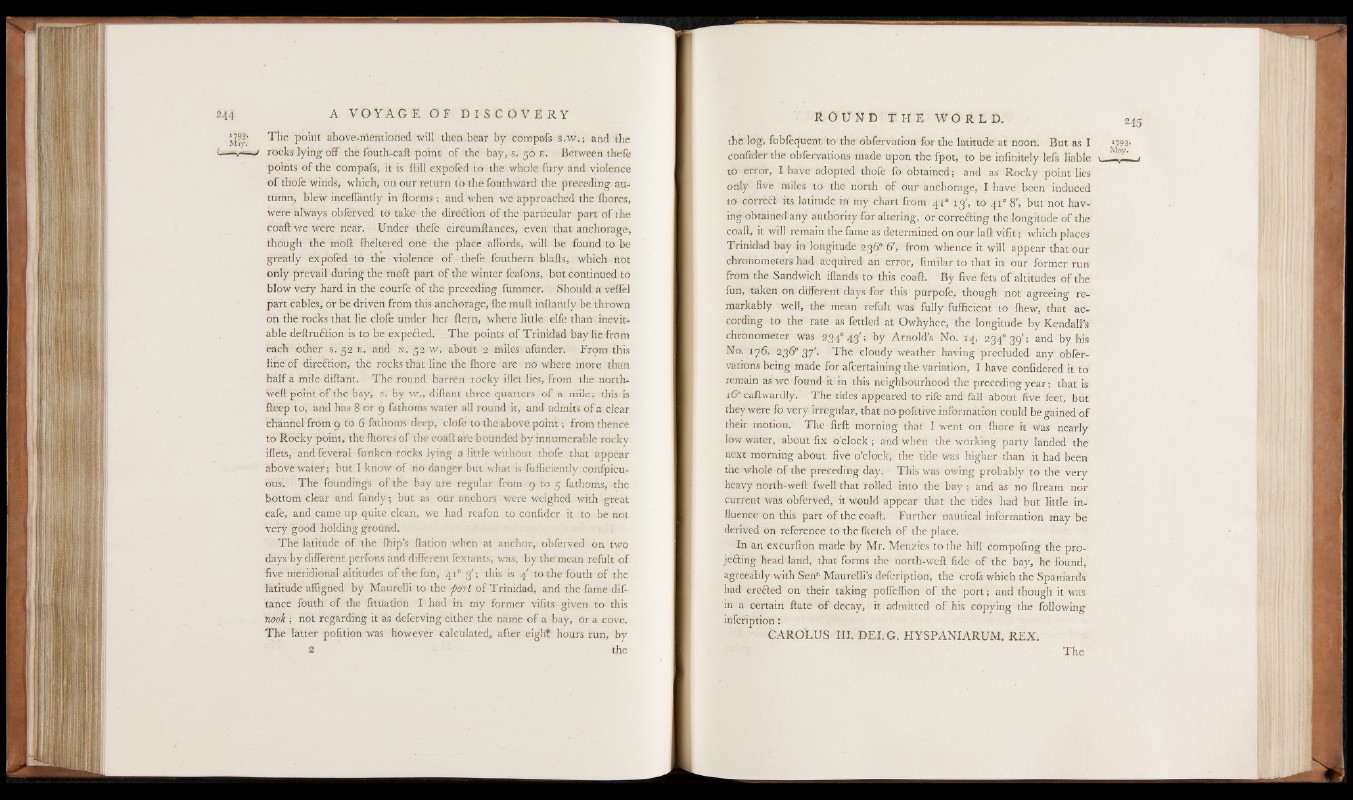
j| jp The point above-nientioned -frill then bear by compafs s.w. ;. and the
—r——i rocks lying off the fouth-ea® point of the bay,- Si 5 0 e . Between thefe
points of the compafs, it is ftill expofed to the whole fury and violence
of thofe winds, which, on our return to the fouthwârd the preceding autumn,
blew ineeffantly in ftorms and when we' approached the Chores,
were always obferved to take the direction o f the particular part of the
coaft we Were near. Under thefe circumftances, even that anchorage,
though the mo® lheltered one the place affords, will be found to be
greatly expofed to the violence o f thefe fouthern blafts, which not
only prevail during the mo® part of the winter feafons, but continued to
blow very hard in the courfe of the preceding fummer. Should a veffel
part cables, or be driven from this anchorage, lhe mu® inftantly be thrown
on the rocks that lie clofe under her ftern, where little elfe than inevitable
deftruflion is to be expefted. The points of Trinidad bay lie from
each other s. 52 E. and n. 52 w . about 2 miles afunder. From this
liné'of direction, the rocks that line the Ihore are no where more than
half à mile diflant. The round barren rocky iflet lies, from the north-
weft point of the bay, s. by w., diftant three quarters of a mile; this is
fteèp to. and has '8 or 9 fathoms water all round it, and admits o f a clear
channel from 9 to 6 fathoms deep, clofe to the.above point ; from thence
to Rocky point, the fliores of the coaft arc bounded by innumerable rocky
iflets, and feveral funken rocks lying a little Without thofe that appear
above water; but I know o f no danger but what is fufficiently confpicu-
ous. The foundings of the bay are regular from g to 5 fathoms, the
bottom clear and fandy ; but as our anchors were weighed with great
eafe, and came up quite clean, we had reafon to confider it to be not
Very good holding ground.
The latitude of the {hip’s ftation when at anchor, obferved on two
days by different perfons and different fextants, Was, by the mean refult of
five meridional altitudes of the fun, 410 3' ; this is 4' to the fouth o f the
latitude afftgned by Maurelli to the port of Trinidad, and the fame distance
fouth of the fitüation I had in my former vifits given to this
nook ; not regarding it as deferving either the name of a bay, Or a cove.
The latter pofition was however calculated, after eight hours run, by
2 the
the log, fubfeqoent to the obfervation for the latitude at noon. But as I
confider the obfervations made upon the fpot, to be infinitely lefs liable
to error, I have adopted thofe fo obtained; and as Rocky point lies
only five miles to the north o f Our anchorage, I have' been induced
to cörrè£ï its latitude in my chart from 4U 13', to 41“ 8', but not having
obtained any authority for altering, or correding the longitude of the
coaft, it will remain the fame as determined On our laft vifit; which places
Trinidad bay in longitude 236° S', from whence it will appear that our
chronometers had acquired an error, fimilar to that in Our former run
from the Sandwich iflands to this coaft. By five fets o f altitudes of the
fun, taken on different days for this purpofe, though not agreeing remarkably
well, the mean refult was fully fufficient to {hew, that according
to the rate as fettled at Owhyhee, the longitude by Kendall’s
chronometer was 2340 43'; by Arnold’s No. 14, 2340 39'; and by his
No. 176, 37'. The cloudy weather having precluded any obfervations
being made for afcertaining the variation, I have confidered it to
remain as we found it in this neighbourhood the preceding year; that is
160 eaftwardly. The tides appeared to rife and fall about five feet, but
they were fo very irregular, that no pofitive information could be gained of
their motion. The firft morning that I went on fhore it was nearly
low water, about fix o’clock ; and when the working party landed the
next morning about five o’clock, the tide was higher-than it had been
the whole of the preceding day. This was owing probably to the very
heavy north-weft fwell that rolled into the bay ; and as rto ftream nor
current was obferved, it would appear that the tides had but little influence
on this part of the coaft. Further nautical information may be
derived on reference to the fketch of the place.
In an excurfion made by Mr. Menzies to the hill compofing the projecting
head land, that forms the north-weft fide o f the bay, he found,
agreeably with Sen'- Mauretli’s defcription, the crofs which the Spaniards
had erefted on their taking poffeflion of the port; and though it was
in a certain ftate o f decay, it admitted of his copying the following
infcription:
CA RO LU S III. D E I .G . HY SPANIARUM . REX.